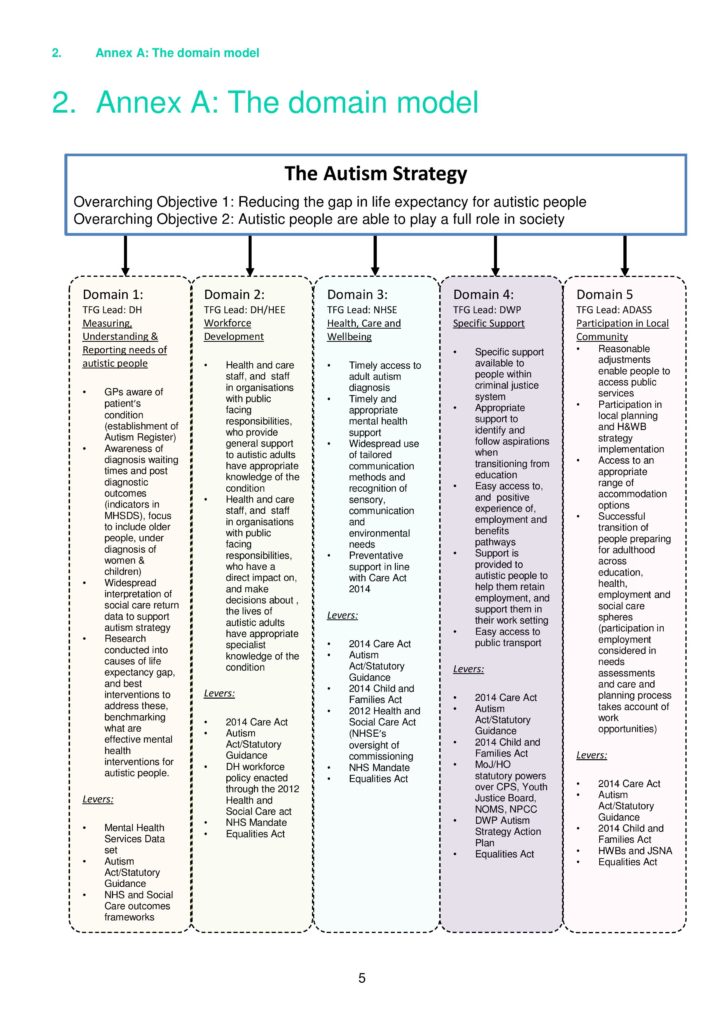The Autism Act (2009) places a duty on the Secretary of State for Health and Social Care to publish a strategy for meeting the needs of autistic adults in England, and to review it from time to time. England’s first Adult Autism Strategy, Fulfilling and Rewarding Lives, was published in 2010, with commitment from Ministers across government to transform the support for and
experience of autistic people. In April 2014, the Strategy was updated with the publication of Think Autism, supported by revised Statutory Guidance in March 2015.
In 2017, it was agreed that the arrangements for overseeing implementation of the Strategy should be refreshed. In some areas, it was agreed with stakeholders that progress was not as quick as envisaged, and that there was scope to streamline the set of actions and commitments and to re-confirm ownership of specific actions to focus on those that would best realise the objectives of the Strategy.
The Strategy itself has not changed, but the implementation activities required to deliver its intended outcomes, and who will do what, have been clarified. This has returned the focus to delivering what is required by the Autism Act and Statutory Guidance, in a realistic and measurable way.
A revised governance model
A revised governance model to oversee implementation of the Strategy has been established, which centres on 19 overarching strategic objectives. These were identified from the existing Strategy, and have a direct read across to the core aims of the Autism Act and the associated Statutory Guidance. The 19 strategic objectives have been grouped into five domains:
Measuring, Understanding and Reporting the needs of people with autism;
Workforce Development;
Health, Care and Wellbeing;
Specific Support;
and Participation in the Local Community.
There will be five Task and Finish Groups (TFG), one for each domain, which will
be responsible for coordinating the delivery of the relevant objectives, and tracking progress of the associated actions. A diagram of the model can be found in Annex A.
Each TFG will be composed of members representing organisations which have the levers, authority and ability to take action to realise the objectives in each specific area. The Chair of each TFG represents the organisation best placed to facilitate overall progress in that domain, and they will be able to influence progress against their objectives. Additionally, at least two members of each group will be self-advocates to ensure that the voice of people affected
ultimately by the work of the TFGs is represented. The terms of reference for each group clearly sets out each member’s role and responsibilities to drive forward progress in their area.
A new Executive Group will oversee the progress of the TFGs, coordinate actions across the Strategy as a whole and monitor and report on the overall progress against the strategic objectives. Progress, risks and issues from the TFGs will be reported into the executive group.
This will help to ensure that activities across the groups are joined up. Every year, the executive group will present the progress in implementing the Strategy to an annual accountability meeting, chaired by a Department of Health and Social Care Minister.
Each TFG will be composed of members representing organisations which have the levers, authority and ability to take action to realise the objectives in each specific area. The Chair of each TFG represents the organisation best placed to facilitate overall progress in that domain, and they will be able to influence progress against their objectives. Additionally, at least two members of each group will be self-advocates to ensure that the voice of people affected
ultimately by the work of the TFGs is represented. The terms of reference for each group clearly sets out each member’s role and responsibilities to drive forward progress in their area.
A new Executive Group will oversee the progress of the TFGs, coordinate actions across the Strategy as a whole and monitor and report on the overall progress against the strategic objectives. Progress, risks and issues from the TFGs will be reported into the executive group.
This will help to ensure that activities across the groups are joined up. Every year, the executive group will present the progress in implementing the Strategy to an annual accountability meeting, chaired by a Department of Health and Social Care Minister.
The aims and the objectives of the Think Autism Strategy stand but the revised governance model is expected to help drive progress this year before a formal review of the Strategy in 2019
